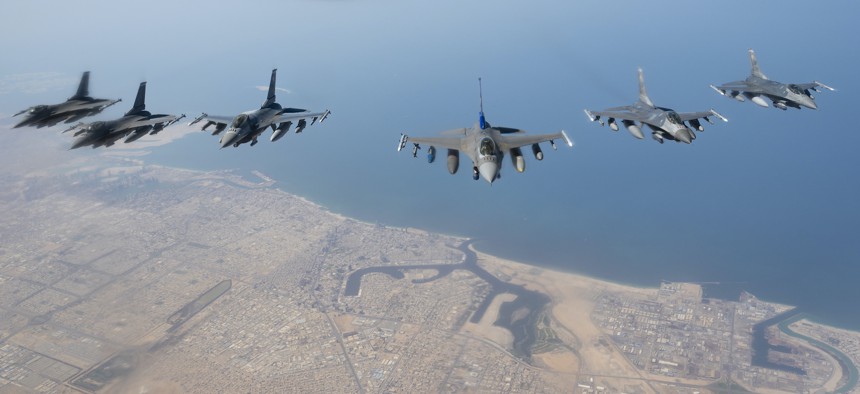
U.S. Air Force F-16 Fighting Falcons assigned to the 332d Air Expeditionary Wing fly in formation above the Arabian Gulf en route to an exercise with a partner nation, Feb. 26, 2022. U.S. Air Force / Staff Sgt. Jerreht Harris
The Air & Space Brief: Ukraine-ISS impact; Fighter jets to Ukraine; Will Starlink save the day?
Welcome to the Defense One Air and Space newsletter. Here are our top stories this week:
Russia-US ISS Impact: The United States and Russia are maintaining their peaceful, working relationship in space despite the crisis in Ukraine, a senior NASA official said on Monday—but America’s space agency is weighing its options if Russia does not hold firm on its responsibilities associated with the International Space Station. “Obviously, we understand the global situation, where it is. But—as a joint team—these teams are operating together.”
Fighter jets to Ukraine: Perhaps the most eye-popping of the European Union’s pledges to ship weapons to the Ukrainian military was the European Union’s announcement that it would send fighter jets. Though the plan didn’t pan out, it still raises the question: Would Ukrainian pilots really be able to jump in a donated jet and fly into combat? Former Air Combat Command head Herbert “Hawk” Carlisle says sure, if it’s a type they already know how to fly.
JSTARS tracks Russian movements: Three decades after its first mission, one of the most capable American spy planes is finally doing the job it was built for: tracking Russian forces as they invade eastern Europe. The E-8C Joint Surveillance Target Attack Radar System, or JSTARS, has spent its career flying missions from Desert Storm to the wars in Iraq and Afghanistan. “It was designed in response to the Soviet threat in Eastern Europe, almost exactly what's happening right now,” an Air Force official said.
Will Starlink save the day? Not so fast, argues Atlantic contributor Marina Koren, arguing that the lack of terminals and previous difficulties Elon Musk’s satellite-based Starlink internet capability has experienced maintaining signal, as well as the potential risk for airstrikes against troops on the ground if the Starlink transmission reveals soldiers’ locations, make it less of the “magic fix” than many people assume, Koren wrote. “None of this is new,” said John Scott-Railton, a senior researcher at the University of Toronto’s Citizen Lab. “The only new thing is Starlink, which has never really been tested in a context of battle.”
Sign up to get The Air & Space Brief every Tuesday from Tara Copp, Defense One’s Senior Pentagon Reporter. This week in space history: On Mar. 3, 1972, NASA launched probe Pioneer 10 to begin exploring Jupiter. It transmitted through May 1991.
 From Defense One
From Defense One
Despite U.S.-Russia Tensions, the First All-Commercial Flight to ISS is Still On // Brandi Vincent
An initial launch is set for late March, officials confirmed.
Can Ukraine Really Use Donated Fighter Jets? That Depends // Marcus Weisgerber
After EU says it will send some aircraft to Ukraine, a retired U.S. fighter chief explains how that might work.
Above Ukraine, a Cold War Spy Plane Is Finally Tracking a Russian Invasion // Marcus Weisgerber
Air Force officials had already started retiring 30-year-old E-8C JSTARS.




